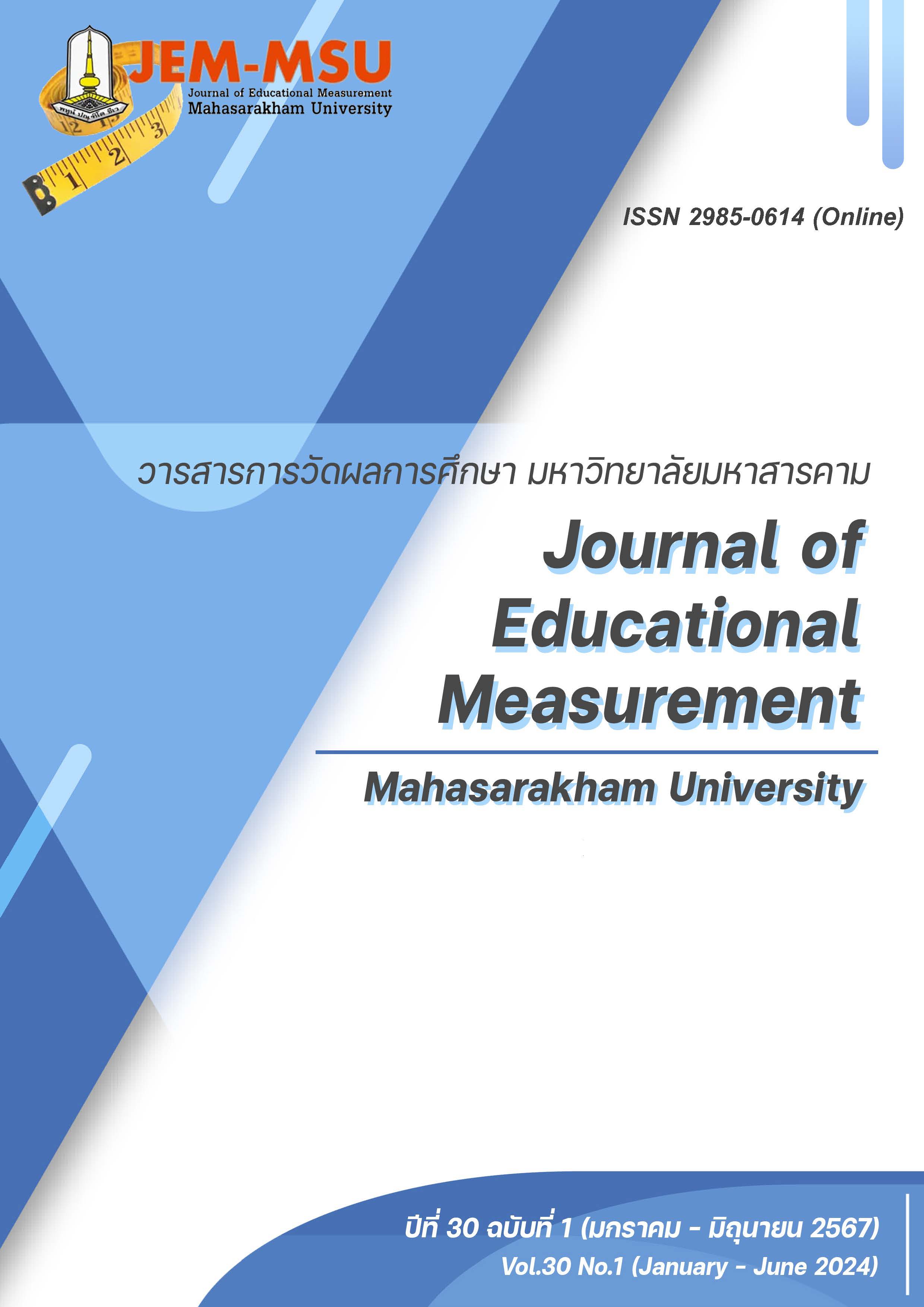Artificial Neural Network Applications in Selecting the Next Item for Multidimensional Computer-Adaptive Testing
Main Article Content
Abstract
Selection for the next item using an artificial neural network has five important steps: 1. Dataset; 2. Data Preparation, comprising 2 methods—2.1 Formatting, followed by Data Transformation, and 2.2 Data Cleaning; 3. Modeling with Algorithms—Neural Net, Data mining by dividing the dataset into two parts: Train set—80%; Test set—20%. Adjust the parameter of the Neural Network to obtain the highest efficiency in the Training Cycle, Learning rate, and Momentum; 4 Test the performance of the model with the 10-fold cross-validation method and evaluate the performance of the model (Evaluation) with accuracy, precision, recall, and f-measure; and 5. Deployment Stage by developing the model in the form of a web application MCAT, using PHP language, scripting various commands, using the Prediction API (Application Programming Interface) to connect the algorithms Neural Net with the MCAT application in the item selection algorithm stage, and using a MySQL database for storing each attribute on cloud hosting.
Article Details

This work is licensed under a Creative Commons Attribution-NonCommercial-NoDerivatives 4.0 International License.
The content and information contained in the published article in the Journal of Educational Measurement Mahasarakham University represent the opinions and responsibilities of the authors directly. The editorial board of the journal is not necessarily in agreement with or responsible for any of the content.
The articles, data, content, images, etc. that have been published in the Journal of Educational Measurement Mahasarakham University are copyrighted by the journal. If any individual or organization wishes to reproduce or perform any actions involving the entirety or any part of the content, they must obtain written permission from the Journal of Educational Measurement Mahasarakham University.
References
Frey, A., & Seitz, N. N. (2009). Multidimensional adaptive testing in educational and psychological measurement: Current state and future challenges. Studies in Educational Evaluation, 35(2), 89-94. https://doi.org/https://doi.org/10.1016/j.stueduc.2009.10.007
Jain, A. K., Jianchang, M., & Mohiuddin, K. M. (1996). Artificial neural networks: a tutorial. Computer, 29(3), 31-44. https://doi.org/10.1109/2.485891
Koçak, B., Durmaz, E. Ş., Ateş, E., & Kılıçkesmez, Ö. (2019). Radiomics with artificial intelligence: a practical guide for beginners. Diagnostic and interventional radiology (Ankara, Turkey), 25(6), 485-495. https://doi.org/10.5152/dir.2019.19321
Li, X., Xu, H., Zhang, J., & Chang, H. H. (2020). Deep Reinforcement Learning for Adaptive Learning Systems. Journal of Educational and Behavioral Statistics, 48, 220 - 243.
Lord, F.M., Novick, M.R., & Birnbaum, A. (1968). Statistical theories of mental test scores. Addison-Wesley.
McDonald, R. P. (2000). A Basis for Multidimensional Item Response Theory. Applied Psychological Measurement, 24(2), 99-114. https://doi.org/10.1177/01466210022031552
Mujtaba, D., & Mahapatra, N. (2020). Artificial Intelligence in Computerized Adaptive Testing. 2020 international Conference on Computational Science and Computational Intelligence (CSCI). 649-654. https://doi.org/10.1109/CSCI51800.2020.00116
Phankokkruad, M., & Woraratpanya, K. (2012). Item classification algorithm for computer adaptive testing based on web services. International Journal of Engineering Research and Applications, 2(1), 835-847.
Prakorppon, T. (2009). Artificial neural networks. HCU Journal, 24(1), 73-87.
Reckase, M. D. (2010). Designing item pools to optimize the functioning of a computerized adaptive test. Psychological Test and Assessment Modeling, 52(2), 127-141.
Teiri, H., Hajizadeh, Y., Samaei, M. R., Pourzamani, H., & Mohammadi, F. (2020). Modelling the phytoremediation of formaldehyde from in door air by Chamaedorea Elegans using artificial intelligence, genetic algorithm and response surface methodology. Journal of Environmental Chemical Engineering, 8(4), 103985. https://doi.org/https://doi.org/10.1016/j.jece.2020.103985
Tsutsumi, E., Kinoshita, R., & Ueno, M. (2021). Deep Item Response Theory as a Novel Test Theory Based on Deep Learning. Electronics, 10(9), 1020. https://www.mdpi.com/2079-9292/10/9/1020
Uto, M., & Uchida, Y. (2020). Automated short-answer grading using deep neural networks and item response theory. In Bittencourt, I., Cukurova, M., Muldner, K., Luckin, R., & Millán, E (Eds.), Artificial intelligence in education. AIED 2020. Lecture notes in computer science (Vol. 12164). Springer. https://doi.org/10.1007/978-3-030-52240-7_61
Chanthasaeng, S. (2020). Application of multidimensional computerized adaptive testing. CUAST Journal, 9(3), 137–148. (in Thai)
Chongwatpol, J. (2018). Business data analytics for strategic decisions. Chulalongkorn University Press. (in Thai)
Kanjanawasee, S. (2012). Modern test theory (4th ed.). Chulalongkorn University Press. (in Thai)
Premthongsuk, P. (2017). Development of the next item selection procedure using Hurwicz criterion with the item exposure control for computerized adaptive testing [Doctoral dissertation]. Burapha University. (in Thai)
Rungratanaubon, C. (2023). Data Mining Techniques. Naresuan University Press. (in Thai)
Sinsomboonthong, S. (2017). Data mining 1: discovering knowledge in data (2nd ed). Chamchuri Products Press. (in Thai)
Sotiwan. T. (2015). Statistical analysis using neural networks in social science research. SSRU Graduate Studies Journal Suan Sunandha Rajabhat University, 8(1). 84-91. (in Thai)
Sukhanonsawat, S. (2013). Development of the Next Item Selection Procedure Using Decision Theory in Computerized Adaptive Testing [Doctoral dissertation]. Burapha University. (in Thai)
Thanapattanadol, R. (2018). Development of the Next Item Selection Procedure Using Ant Colony Optimization for Computerized Adaptive Testing [Doctoral dissertation]. Burapha University. (in Thai)
Withipanya, B. (2021). Development of The Next Item Selection Procedure Using Artificial Neural Network with The Item Exposure Control for Computerized Adaptive Testing Using Simulated Data. Journal of Faculty of Education Pibulsongkram Rajabhat University, 8(1) (January–June 2021), 37-48. (in Thai)


